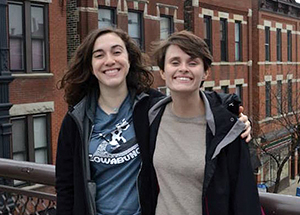Students’ Research Leads to Himalayan Journey
An idea that began with a Google search in a University of Pittsburgh residence hall will continue this summer with a trip for two Pitt students to the Himalaya Mountains in the northern province of Ladakh, India.
 Naomi Anderson and Taylor Shippling, both third-year civil engineering majors in Pitt’s Swanson School of Engineering, were freshmen when they teamed up to research and write a required paper for their first-year engineering conference. The annual professional-style conference requires each Swanson student and an academic partner to spend a semester writing a research paper, which is ultimately presented to peers, faculty, alumni, and family.
Naomi Anderson and Taylor Shippling, both third-year civil engineering majors in Pitt’s Swanson School of Engineering, were freshmen when they teamed up to research and write a required paper for their first-year engineering conference. The annual professional-style conference requires each Swanson student and an academic partner to spend a semester writing a research paper, which is ultimately presented to peers, faculty, alumni, and family.
Because both women shared an interest in climate change and water resource engineering, they ultimately chose a topic that sounded interesting, if not mysterious: artificial glaciers.
“We first Googled ‘glaciers’ and ‘civil engineering’ and ‘artificial glaciers’ was the first thing that came up in the search results—we had never heard of them. There was hardly anything written about them,” Anderson says. “That made writing the paper pretty tough, but we were fascinated by what we found.”
What exactly are artificial glaciers?
Artificial glaciers are constructed by channeling the flow of natural-glacier water into strategically placed natural reservoirs on mountains. The reservoir water eventually freezes, creating an artificial glacier whose melting process can be timed to suit the agricultural needs of communities below.
These engineered glaciers have become necessary in some parts of the Himalayas as natural glaciers melt and retreat over time. That melting process—accelerated by global climate change—ultimately results in water taking more time to reach the communities below.
“That affects their planting seasons and irrigation, and because their summers are so short, it can be devastating to their way of life,” Anderson says.
The Pitt duo presented their research at the annual First-Year Engineering Conference, and their paper, like those of their classmates, was uploaded to Pitt’s Swanson School of Engineering Web site.
Meanwhile, Carey Clouse, a professor at the University of Massachusetts-Amherst, was doing some Googling of her own. Clouse, an expert in climate change and landscape architecture in Northern India, came across the paper by Anderson and Shippling.
The women said Clouse contacted them toward the end of their sophomore year to ask a few civil-engineering-related questions about artificial glaciers. Clouse called again last September to relay that she had cited the women’s research in a journal article. And oh, by the way, would they like to see artificial glaciers first-hand with her in Leh, India, this summer? Clouse was planning to conduct research there as a Fulbright Fellow.
“I remember being pretty surprised,” Shippling recalls. “First, because [the research paper] was just a freshman engineering project, and I didn’t think it’d be visible for someone outside the University to find. Second, because I definitely didn’t think it’d be taken seriously enough for anyone to care about it.”
“It’s amazing what can happen when you take an assignment and really put your heart into it—this is such a unique experience, and it definitely wouldn’t have happened if Naomi and I hadn’t searched awhile to find a topic we truly cared about.”
Clouse called Shippling and Anderson’s research paper “one of the best academic reports” she had read about artificial glaciers. She said she was impressed by their interest and professionalism—both of which she observed through initial emails and Skype sessions with the students.
“I realized they would provide a useful engineering lens that could help move the research project forward,” Clouse said.
Kent Harries, a Pitt professor of structural engineering and mechanics in the Department of Civil and Environmental Engineering, who also has experience working in the Himalayas, is advising the two students. He said the Swanson School is supporting the women’s trip through their undergraduate summer research internship programs.
“Opportunities and recognition beyond our University walls are always important; for this to result directly from freshman research is an outstanding validation of the quality of our students and their efforts,” Harries says. “This project complements the emphasis by the University, the Swanson School, and the Mascaro Center on international experience and social entrepreneurship. Such external collaboration can only broaden the opportunities we can offer our students.”
Shippling and Anderson say they will spend June and July in Leh, India, at an elevation of about 11,000 feet. They will study the construction and placement—and try to do some hydrological modeling—of artificial glacier systems. In addition, they plan to interview villagers about their agricultural and water needs.
Both students said they plan to detail their experience and findings in a technical paper, and they hope to apply what they learn to future studies in water resources and civil engineering.
“We want to help support the body of literature on artificial glaciers. There is hardly anything written about them despite the technology’s success,” Taylor says. There are 12 highly functioning artificial glaciers currently in operation around the Ladakh region.
“To be given the chance to see upfront what we are studying is such a gift,” Anderson says.
Other Stories From This Issue
On the Freedom Road

Follow a group of Pitt students on the Returning to the Roots of Civil Rights bus tour, a nine-day, 2,300-mile journey crisscrossing five states.
Day 1: The Awakening
Day 2: Deep Impressions
Day 3: Music, Montgomery, and More
Day 4: Looking Back, Looking Forward
Day 5: Learning to Remember
Day 6: The Mountaintop
Day 7: Slavery and Beyond
Day 8: Lessons to Bring Home
Day 9: Final Lessons

